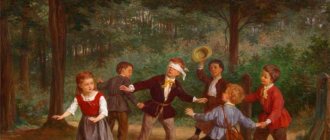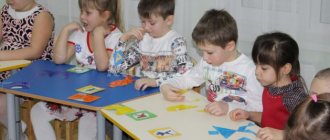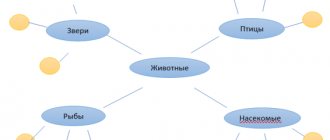Consultation for teachers of preschool educational institution “Folk art in the everyday life of kindergarten”
Marina Artemkina
Consultation for teachers of preschool educational institution “Folk art in the everyday life of kindergarten”
Folk art in everyday life in kindergarten.
There are many items of Russian folk art that can decorate our everyday life. Fine, verbal, and musical folk art is introduced into kindergarten in connection with the needs of children's life , in order to decorate everyday life.
Russian folk art is diverse in its manifestations. It penetrates into every corner of life around us.
From an early age, a child, through nursery rhymes, lullabies, jokes, and songs in accessible forms and based on material similar in content, learns the language of his people , its morals and customs, and character traits.
Games while the child is small are addressed to him individually. He is amused and entertained with simple games with sounding, noisy, colorful toys, games and jokes. Here "Ladushki"
,
"white-sided magpie"
. Such games are used in classes and in a child’s daily life.
Folk games influence the development of the mind, character, will, develop moral feelings, and physically strengthen the child. folk games are figurative , so they captivate preschoolers.
Very enthusiastically, children play folk outdoor games in kindergarten : “Geese - geese”
,
“By the bear in the forest”
,
“Kite, hen and her babies”
. The structure of these games is simple. Song, word, movement are limitedly connected in them. This creates classical simplicity, utmost completeness, completeness.
Folk games are often preceded by counting rhymes. The counting book, as it were, introduces the game, helps distribute roles, and serves as self-organization for children. Public such folk rhymes :
Cads - bads, peas rolled on a saucer
Pour water, you drive, but I won’t.
For a cow to drink, Threads and needles,
You should drive. Tee-tee fly away.
Counting rhymes show children's verbal creativity. Here we find dance rhythms, imitations, play with words and sounds.
Also, a number of games are based on combining song with movement. These are round dance games. In these games, the child dramatizes what is sung in the song. Children love to play games such as "Loaf"
,
"Golden Gate"
.
"bunny
"
Although now round dance games have begun to be used mainly only in music classes. This happened and gradually they disappear from everyday life, and this is sad. Therefore, attention should be paid to the revival of folk round dancing games .
Folk games were created by the people as songs and fairy tales . They are passed on from generation to generation. kindergarten adopt these games , playing with each other, on the street, from older children. Ushinsky K.D. considered these games of materials to be the most accessible and understandable for children, due to the closeness of their images and plots to children's imagination , as well as due to the social principle inherent in them.
Folk toys have long been part of children's everyday life. These are balls, pyramids, shaped toys: bears - blacksmiths, wicker doll furniture, nesting dolls, etc. The toys attract the attention of children with an unusual shape, amazing coloring - these are Dymkovo or Gorodets horses, whistles. The figures of a woman, horse, rooster, bear, presented in the toy, show the connection of the toy with folk art . Folk toys are designed to please children with the brightness of their colors. She delights children with whistles, squeaks, and actions. Vankas, tumblers, pipes, clowns, and whistles are widely known and loved by preschool children. Toys for the development of movements are interesting and acceptable for children - gurneys, balls, grandmothers, towns.
Folk toys have valuable didactic properties. The child learns to distinguish colors and shades, becomes familiar with size, shape, and quantity. Children play with interest with toys - inserts, where they learn to insert, arrange, rearrange.
In kindergarten , it is recommended to offer stringing toys: balls, pyramids, mushrooms.
Narrative folk toys are :
• Gorodets wooden toy (horses, people, ships)
• Dymkovo clay toy, surprisingly simple in plot, characterized by clarity of shape combined with lively coloring (stables, riders, rams)
• Zagorsk papier-mâché toys (dappled gray horses with tow tails, with stands on wheels)
• Bogorodsk carved toy (animal figures)
.
Folklore has a huge influence on the development of speech . The child learns his native language by imitating the speech of those around him. Perfect examples of the Russian language are proverbs, riddles, fairy tales, sayings, tongue twisters, lullabies, chants, teasers, scares. Proverbs and sayings help children discover rules of behavior and moral standards. For example:
“If you hurry, you’ll make people laugh”
,
“The day is boring until the evening - if there is nothing to do,”
etc.
Riddles are easy for a child to understand and useful exercises for his mind. Learning and pronouncing tongue twisters helps children practice articulation. They are necessary and useful as speech gymnastics.
Calls help children feel the beauty of nature, encourage them to love and take care of it. For example: “The sun is a bucket”
,
“The wind is a breeze”
,
“Rain, rain, more.”
The richest treasury of the Russian language is a folk tale . Children listen carefully to fairy tales and easily assimilate the content. Based on fairy tales, they learn to distinguish good from evil.
The fairy tale theme is so close to children that it easily penetrates into the game. Dramatization of fairy tales teaches you to translate images of the imagination into the language of gestures, facial expressions, words, enriches vocabulary, and develops memory. This year, in classes on theatrical activities, we pay a lot of attention to folklore : tongue twisters, counting rhymes, dramatizations of fairy tales, introduced folk , nursery rhymes, and horror stories.
with folk crafts , traditions, and folklore during holidays and folk festivals , since children’s lives increasingly include songs sung by adults during these holidays. Children with interest, accompanied by playing folk musical instruments, sing folk songs “Oh, you canopy, my canopy”
,
“Is it in the garden”
,
“The moon is shining”
,
“Savka and Grishka”
,
“Kalinka”
, and they also stage them.
Based on folk melodious songs , round dances, and games, children discover the breadth of folk culture , its scope, gentleness and sincerity.
There are many folk art items that can decorate the interior of a kindergarten .
Zhostovo trays are pleasant in their colorful design. They can be used for table setting.
The use of carving and painting can decorate children's furniture .
Carved or wicker boxes can be used to store sewing supplies and pencils.
Folk art in the form of decorative panels and sculptures can be used to decorate kindergartens A panel appliqué made based on a smoky toy can be successfully used; , as well as Bogorodsk wooden sculpture: a bear, a goat, a deer, a kindergarten
Russian embroidery and lace can serve as an excellent decoration for curtains, tablecloths, and napkins.
Each thing made by a folk craftsman must be found in a place, not obscured by other objects, so that it can be seen by children.
ON THE DEVELOPMENT OF CREATIVE ABILITIES OF PRESCHOOL CHILDREN THROUGH THEATER ACTIVITIES BASED ON FOLK ARTS .
teacher Artemkina Marina Pavlovna
Theatrical activity is a very complex internal activity that develops over time, in which imagination, perception, attention, thinking, memory, emotions and will are involved. With the development of mass television, reading fairy tales became rare. In a duel with a book, television easily emerged victorious: watching the show is easier and more interesting. And in this regard, the fairy tale has ceased to be used for the development of creative thinking and imagination, speech creativity and the active education of moral feelings. Also, fairy tales are not presented to preschoolers in a variety of ways, mainly reading, rarely telling, at best - retelling in person, watching films based on familiar fairy tales. And it’s not even worth talking about visiting theatrical performances. But over the years kindergarten teachers have been convinced that children love fairy tales. From them they draw a lot of knowledge: the first ideas about the life of people in the past, about time and space, about the connection between man and nature, about the world of the subject. Fairy tales allow a child to experience courage and resilience for the first time, to see good and evil.
Based on folklore and fairy tales, children learn to improvise with words, intonation, gestures and facial expressions when playing roles in games - dramatization and theatrical performances. Since fairy tales are not fully used in the family for the creative development of children, in kindergarten strive to focus on the development of theatrical skills and abilities based on familiarizing preschoolers with folklore : fairy tales, counting rhymes, horror stories, teasers, tongue twisters, nursery rhymes and upside-down games. These words are rarely used in speech nowadays, so together with the children we are looking for an explanation of their formation (etymology)
.
Children offer very diverse meanings of native words . Folklore is a vivid speech material, easy to memorize and convey dialogue. For example:
• Fedul, why are you pouting your lips?
• The caftan is burned!
• How big is the hole?
• One sleeve left!
Children independently convey such short texts in dialogues, improvising intonation expressiveness, facial expressions and gestures with elements of folk humor .
Children like to dramatize dialogues from fairy tales, invented independently on the proposed topic: “Magic meetings”
(meeting of animals in the forest; meeting of Little Red Riding Hood with a bun, etc.)
. Reflecting their judgments in speech, children convey creative information to various questions, for example: “If I were a knight, what would I do?; If I were a fox, how would I make peace with the wolf? etc."
Discussing the content of fairy tales with children, we often see that the fox in fairy tales is always cunning, and the cat deceives many in order to achieve its goal. It is not for nothing that there is a saying: A fairy tale is a lie, but there is a hint in it, a lesson for good fellows. Together with the children, we identify this “hint”
so that children act morally in the future. For example: To be kind as Emelya, but not to be lazy while sitting on the stove.
In this regard, we pay special attention to playing out familiar fairy tales in a new way, where, together with the children, we rearrange the content of the fairy tale taking into account the development of civilization, changes in characters, movements, but leaving folk expressions . From this side, the theory of solving inventive problems (TRIZ, which should be included in theatrical activities) helps
folk Until recently, it was believed that preschoolers do not understand the figurative meaning of proverbs. By analyzing them with children and discussing the meaning, we help children understand and apply proverbs by purpose, for example: it is rational to tie the proverb “Maslenitsa is not all for the cat”
, where a cat can be full only on a holiday, but a holiday doesn’t happen every day, and you need to work hard to eat well.
Thus, by analyzing the content of proverbs, we expand our understanding of folk holidays , traditions and customs.
The development of creative speech potential should be carried out together with singing and visual activities. Since only a complete understanding of children’s folk culture can form an idea of their people .
We must strive to introduce children to different types of national art : from dancing to fairy tales, music and visual arts to theater. This is exactly what the strategy for developing a child’s personal creative culture seems to be in our time.



